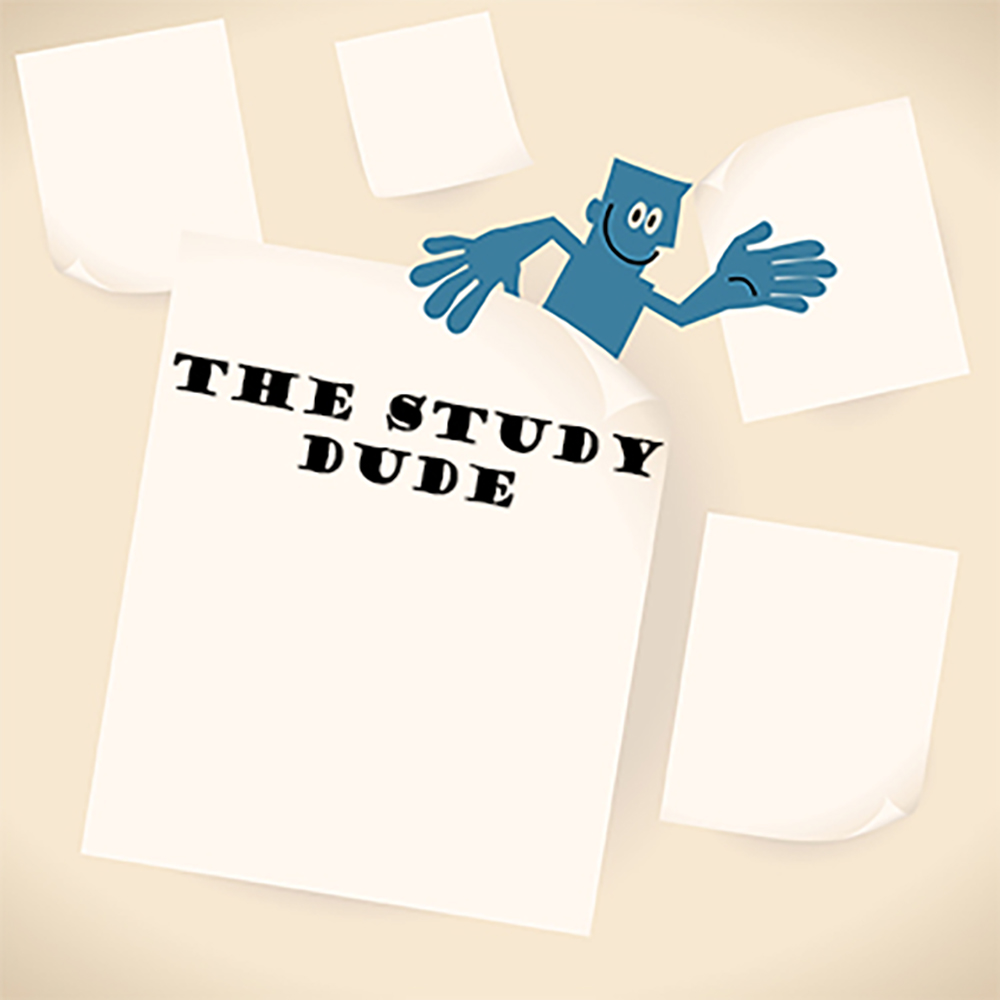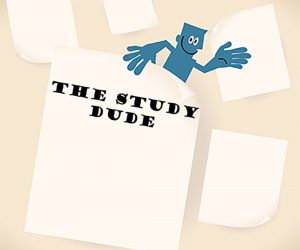 There is nothing more that The Study Dude wants for you than to apply a mash-up of theories in your analysis.
There is nothing more that The Study Dude wants for you than to apply a mash-up of theories in your analysis.
Well, in these articles, as The Study Dude, I’ll try to give you the study tips you need to help make your learning easier. I’ll also give you straight and honest opinions and personal anecdotes?even the embarrassing ones that you wouldn’t ever dare read about from any other study tip guru.
This week’s Study Dude further explores InterViews: Learning the Craft of Qualitative Research Interviewing by Svend Brinkmann and Steinar Kvale. The authors list ways to analyze your interviews: the make-it-up-as-you-go way, the formal way, and the jack-of-all theories way.
The Make-It-Up-as-You-Go Way: Ad Hoc Interview Analysis
I know. I know. You don’t want to take another five year program just to learn how to analyze an interview. So, Brinkmann and Kvale show you the lazy (ahem! I mean “ad hoc”) way. Just make it up as you go.
Let’s take a master researcher and writer, Dr. Helen Sword. Sword wrote a life-altering book on how to write academically. In her book, Stylish Academic Writing, Sword documents a massive amount of books she read on how to write.
So, how does she analyze the hoards of books she reads?
Well, I’d have to ask Helen her exact approach or pay closer attention to her methods chapter. But, I do believe she counted how many of the books advocated for or against things like using passive verbs or personal pronoun. In other words, she used one of the tools that Brinkmann and Kvale suggest for analyzing data: simply stated, counting.
And if something in your data strikes you with the Wow! factor, mark that tidbit with a yellow highlight. When I seeks quotes for my papers, I always try including such anomalies and gems: the wha’? and wow! moments end up in my final drafts. Finding surprises and anomalies serves as yet another ad hoc tool for analyzing info, according to Brinkmann and Kvale.
So, if you can include something startling in not just your interview data, but also your term paper, then do so. Others likely will find it stimulating too. And your professors will thank you for the adrenaline rushes during the otherwise humdrum monotony of marking papers.
So, Brinkmann and Kvale tell you the easy (ad hoc) way of assessing your interviews:
– Make your assessment with whatever tools you find available: mix and match.
– Count the quotes that support a view or disconfirm a view?and compare. Better yet, count quotes that more than just support or not support a view: get multiple angles.
– Get a general sense of the document, a sense which qualifies as part of your analysis.
– Look at the stuff in your data that excites you. Put that stuff aside for further analysis.
– Take little bits and pieces from each interviewee that support a story line: create narratives.
– Use diagrams, figures, and charts, such as mind maps or flow charts to illustrate your analysis.
– Compare and contrast quotes in your data.
– Get the details and put them under headings for your analysis.
– Make logical links between one idea and the next.
– See the relationships between ideas.
– And my favorite, create metaphors. [Yes, creating metaphors seems like the best idea because, frankly, I don’t know how to create one. But, to settle that curiosity, I found a book by philosopher Paul Ricoeur called The Rule of Metaphor: The Creation of Meaning in Language.]
– And the best of all ad hoc styles? Use a blend of any of the above.
The Formal Way: A Taste of Analytic Approaches
If you don’t like the idea of ad-hoc analysis, you can choose a number of analytical approaches that analyze language: conversational analysis, linguistic analysis, discourse analysis, and deconstruction.
One of these approaches, discourse analysis, might suggest that where contradictions exist, power exists. Well, discourse analysis looks at both contradictions and power, not necessarily how they relate. I just thought it sounded neat: where contradictions exist, power exists. (The last comment was inspired by the humor of the managing editor of The Voice himself. He inspires our click-bait titles, too.)
For an example of how power and contradictions relate, in Canada you get a political say only one day every four years?and then you get force-fed whatever comes your way for the remaining 1,459 days (see politicaleconomy.biz). Such practice gets wrongly called democracy. Democracy doesn’t exist in practice, but a contradiction between the meaning and practice of democracy exists, so power relations exist.
And if power relations exist, discourse analysis can reveal these discrepancies and underlying ideologies.
I think I just baffled myself, so surely you must be equally puzzled.
But to clarify, Brinkmann and Kvale list ways to analyze language?and your interviews:
– With linguistic analysis, you look at language pieces, such as grammar, voice, metaphor, and other language devices. [For instance, someone might use the second person (the “you” voice) when belittling others during gossip, while using the first person (the “I” voice) when gossiping about others’ virtues.]
– With conversation analysis, you look at the ways that understanding is forged between the interviewee and interviewer. This type of analysis is pragmatic. You look at how your interviewee uses her words and for what purpose. The transcription requires excruciatingly detailed coding, however, so you might want to limit conversation analysis to just certain parts of your interview.
– With narrative analysis, you look at story elements, such as time, plot, and (social) structure. You could even look at the turning points of a storyline, such as initial incident and the climax. You could make headings, such as “climax” or “antagonists” and put quotes from your interview under each heading.
– With discourse analysis, you look at power structures and ideology. Discourse analysis takes the postmodern view that our world constructs itself from language and social interactions. Contradictions get emphasized here.
– With deconstructionism, you destroy one understanding and replace it with another. With this approach, you look for what is taken for-granted and question it. For instance, if someone asks how does the food taste, you could say, “Do you mean how does the food taste in my mouth or how does the food taste if it had taste buds?” What arises is a lot of discontent. [I’m not sure how such a study would benefit anyone, but Brinkmann and Kvale include it.]
The Jack-of-All-Theories Way: Using Theory in Analysis
Be the jack-of-all-theories for some analytical zest. Try using a single theory or multiple theories if you prefer, or if your supervisor scoffs at the ad hoc approach. Yes, you can pick a theory or several theories. But, make sure your interview data tie into the theoretical framework somehow. To do this, plan your interview so that you ask questions that relate to your theory’s buzzwords.
You can use theories for analyzing documents other than interviews, including art objects, diary entries, or even tweets.
As for the theories to choose from, you can look at postmodern concepts, feminist concepts, critical theory, poststructuralist ideas, existential theory, Freudian theory, or any theory that your uncle Bob happened to publish. And the great thing about it all? You don’t have restrict yourself to just one theory. You can use whatever makes sense for any part of your data. Finally, academic freedom.
One caveat, though?you need deep familiarity with your chosen theories.
And if you love philosophy?and who doesn’t??you’ll love theories. Yet, some philosophers struggle with clear writing. When you come across unclear writing, try to find clearly written alternatives, such as the summary book series called A Very Short Introduction to… . (You’ll find that certain philosophers write beautifully, such as the author of the psychology theory called Flow or the philosopher Roland Barthes.)
So, how do you become a theory master? Devour books and articles on theories such as feminist theory, critical theory, literary theory, sociological theory, communication theory, Darwinian theory, and economics theory. Make reading theory your bedtime past-time.
Brinkmann and Kvale show the way to use theory in your writing and to be a jack-of-all-theories:
– Use a theory. A paradigm is a vogue word for theory. So, use a paradigm instead.
– You can use psychology theories, such as Carl Roger’s, Freud’s, or Skinner’s theories. You can also use Marxism, or hey, maybe you can get away with Capitalism.
– When you use any of the above theories, know that you don’t necessarily need a specific methodology (such as discourse analysis). You can simply reflect on your interview and analyze it according to themes that arise in the theory. And you don’t just have to use one theory?use whatever theories you feel suitable.
– Or you might use postmodern theory. When using postmodern theory, if you come up with multiple interpretations, then good for you. Postmodernists love a “multilayered data analysis” (p. 270). Plus, you won’t get dinged for having invalid interpretations if your supervisor has a different interpretation.
– There is also a realist interpretation. Here you stick to description and observation. You try to find the interviewee’s point-of-view.
– You can also use critical interpretations where you seek power differentials, hegemony, and false consciousness. You assess the social, political, and economic circumstances. [I believe feminism and Marxism would count for critical interpretations, although I’m not sure what is referred to by a false consciousness.]
– Deconstructive readings are where you look for things like silences from the unconscious mind and hidden assumptions.
– If you want to know the name of a study done by a researcher who used more than one theory, look to Hargreaves’s study called Changing Teachers, Changing Times: Teacher’s Work and Culture in Postmodern Age (as cited in Brinkmann and Kvale).
– A fun thing to do involves trying to find alternative interpretations that prove your initial assertion wrong. This way, you strengthen your successive interpretations.
– When you use theories, you don’t need to confine yourself to just one methodology.
– Plan your interviews so you get lots of rich material for the theory you will use in your analysis. In other words, know the theory inside-and-out and plan your questions intelligently.
So, there’s nothing to fear. The Study Dude is determined to make right for you all the wrongs I made in grad school?one A+ at a time.
References
Brinkman, Svend, & Kvale, Steinar. (2015). InterViews: Learning the Craft of Qualitative Research Interviewing. Los Angeles: Sage.
